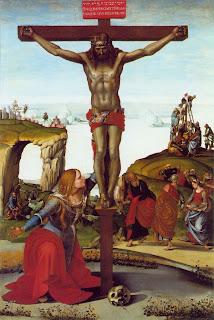Good Friday is the Friday of Holy Week, which commemorates the crucifixion, suffering, and death of Jesus. Good Friday is a fast day in the Catholic Church, and falls within the Paschal Triduum. In 2013 it is celebrated on March 29th (dates in other years). Prayer: Good Friday Prayer.
Basic Facts About Good Friday
Liturgical Color(s): Red (formerly black)
Type of Holiday: Fast day Time of Year: Friday of Holy Week within the Paschal Triduum, and within the traditional 40 day Lenten Fast Duration: One Day
Celebrates/Symbolizes: Jesus' Passion, Crucifixion, and Death
Alternate Names: Good Friday of the Lord's Passion, Great Friday
Scriptural References: Matthew 26-27; Mark 14-15; Luke 23; John 17-19
Introduction
Good Friday is the Friday within Holy Week, and is a time of fasting and penance, commemorating the suffering, crucifixion, and death of the Lord. For Christians, this holy day commemorates not just a historical event, but the sacrificial death of Christ, which along with the resurrection, comprises the heart of the Christian faith. The Catholic Catechism states this clearly:Justification has been merited for us by the Passion of Christ who offered himself on the cross as a living victim, holy and pleasing to God, and whose blood has become the instrument of atonement for the sins of all men (CCC 1992).This is based on the words of St. Paul: "[Believers] are justified freely by God's grace through the redemption in Christ Jesus, whom God set forth as an expiation, through faith, by his blood... (Romans 3:24-25, NAB). The customs and prayers associated with Good Friday typically focus on the theme of Christ's sacrificial death for our sins.
The evening (at sunset) of Good Friday begins is the second day of the Paschal Triduum. The major Good Friday worship services begin in the afternoon at 3:00 PM (the time Jesus likely died). Various traditions and customs are associated with the Western celebration of Good Friday. The singing (or preaching) of the Passion of St. John's gospel consists of reading or singing parts of John's gospel (currently John 18:1-19:42 in the Catholic Church). The Veneration of the Cross is also common in the Western Church. This is when Christians approach a wooden cross and venerate it, often by kneeling before it, or kissing part of it. In addition to these traditions, Holy Communion with the reserved host is practiced. In the Latin Rite of the Catholic Church, no Masses are said on Good Friday or Holy Saturday, therefore the reserved host from the Holy Thursday Mass is used. This is called the "Mass of the Pre-Sanctified."
Many Churches also offer the Stations of the Cross, also called the "Way of the Cross," on Good Friday. This is a devotion in which fourteen events surrounding the death of Jesus are commemorated. Most Catholic Churches have fourteen images of Jesus' final days displayed throughout the parish, for use in public Stations of the Cross services. Another service started by the Jesuit Alphonso Messia in 1732, now less common, the Tre Ore or "Three Hours," is often held from noon until 3:00 PM, and consists of seven sermons on the seven last words of Christ. This service has been popular in many Protestant churches. Good Friday, along with Ash Wednesday, is an official fast day of the Catholic Church.
The Eastern Churches have different customs for the day they call "the Great Friday." The Orthodox Church begins the day with Matins (Morning Prayer), where the "Twelve Gospels" is chanted, which consists of 12 passages drawn from the Passion narratives. In the morning, the "Little Hours" follow one after the other, consisting of Gospel, Epistle, and Prophet readings. Vespers (Evening Prayer) ends with a solemn veneration of the epitaphion, an embroidered veil containing scenes of Christ's burial. Compline (Night Prayer) includes a lamentation placed on the Virgin Mary's lips. On Good Friday night, a symbolic burial of Christ is performed. Traditionally, Chaldean and Syrian Christians cease using their customary Shlama greeting ("peace be with you") on Good Friday and Holy Saturday, because Judas greeted Christ this way. They use the phrase "The light of God be with your departed ones" instead. In Russia, the tradition is to bring out a silver coffin, bearing a cross, and surrounded with candles and flowers. The faithful creep on their knees and kiss and venerate the image of Christ's body painted on the "winding sheet" (shroud). For more information see The Oxford Dictionary of the Christian Church and The Catholic Source Book.

No comments:
Post a Comment